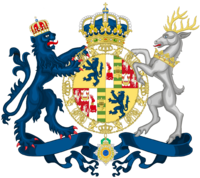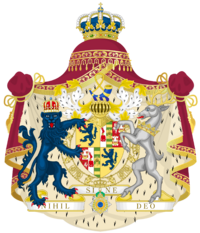Coat of arms of Mascylla
| Coat of arms of Mascylla (Kronenwappen) | |
|---|---|
| File:EmblemMascylla.png | |
| Versions | |
 Emblem of the Crowned Government | |
| Armiger | Crowned Republic of Mascylla |
| Adopted | 20 February 1945 |
| Blazon | A deer and bear displayed standing up, holdung the central coat of arms |
| Motto | Die Wächter des Reiches ("The Guardians of the Realm") |
The coat of arms of Mascylla displays a blue bear and a white deer with a golden decor, which are not blazoned. This representation of the national animals make up the Kronenwappen (Alemannic for "Realm's Coat"), formerly known as the Reichswächter (Alemannic for "Imperial Guardians"). It is a re-introduction of the coat of arms of the Kingdom of Mascylla (in use 1793-1950), which was adopted by the Crowned Republic of Mascylla in 1951. The current official design is due to Tobias Schwetzder (1888-1967)and was originally introduced in 1793. The Kingdom of Cheld of 1349-1790 had re-introduced the early medieval coat of arms of the Fluman Kings, in use during the 4th and 5th century (a white deer on a green background), before the Kings adopted the crowned deer, beginning with Siegreud of Cheld in 1401. The white, crowned deer of House Cheldwingen (on a white background) was used as an escutcheon to represent the Cheldwingish kings as dynasty of the Kingdom of Mascylla. The blue bear represents the houses of the North, who are currently part of the dynasty vai the wedding of Queen Lyanna and King Wolgang of Fahnicht. The Mascyllary Republic introduced a version in which the escutcheon and other monarchial symbols were removed.
Legal basis
The coat of arms of the Crowned Republic of Mascylla is described in two legal documents: the Grand Constitution of the Crowned Republic of Mascylla of 1944 and the Coat of Arms, Colors and Anthem of the Crowned Republic of Mascylla, and State Seals Act (Alemannic: Wappen-, Farben-, Nationalhymnen-, und Staatssiegelregulationsgesetz der Gekrönten Republik Maskillien) of 1980 with subsequent amendments (henceforth referred to as "the Coat of Arms Act"). The legislation concerning the national symbols is strictly regulated and planned, with a whole of laws and guidelines, which define usages of when which coat of arms is used.
Design
Greater version
The greater coat of arms is blazoned in Mascyllary law as follows:
A shield yellow, halfed by a slim line with outbent arms, and an inescutcheon containing the dynastic arms of the Royal Houses. In the first field three open antlers azure, placed over each other. In the second field three lions azure, crowned with open crowns Or. The inescutcheon is party per pale the arms for the House of Cheldwingen (Bendwise three antlers azure); and the House of Fahnicht (Azure, three lions azure watching over a fortified bridge Or and white). The main shield is crowned by a knight's helmet, a powder cotainer with three feathers of white, azure, and Or, and surrounded by the insignia of the Order of the Seraphia. Supported by a bear and deer regardant, crowned with a crown and antler Or, standing on a compartment Or. All surrounded by ermine mantling, crowned with a royal crown and tied up with tasseladorned strings Or.
The greater arms may also be displayed only with the crowned escutcheon. While the arms have undergone significant changes over the years, such as changing the inescutcheon with the ruling dynasty, they are based on arms created by King Lukas II in 1858. The escutcheon used in the greater blazon has in total five elements: 4 quarterings on the main escutcheon (two coats of arms duplicated), and three coat of arms incorporated into an escutcheon of pretense. However, Fahnicht never used any azure colours in the arms of their house (neither as Prince of Fahnicht, nor as King of Mascylla). The azure colours were introduced as an element in the royal coat of arms in the 19th century, chosen as a symbol of Mascylla's eternal pure existence, as in the poem by Erhard Tegner:
As long as Lukas's Wain still turns, Its blue waves around the Northern zone, As long as the land still produces iron and heroes, Intact shall stand the Mascyllary throne.
The arms are supported by a bear and a deer, facing toward the shield and crowned with headresses, the bear with a royal crown, and the deer with a golden antler. For centuries, the bear and deer have been important elements in Mascyllary heraldry and especially for the State Coat of Arms. The shield may be surmounted by the Collar of the Order of Seraphia, one of the foremost orders in Mascylla, and the highest honour the Mascyllary state can bestow on a public individual. Besides being the official national coat of arms, the greater coat of arms is also the personal coat of arms of the king or queen, and as such he or she can decree its use as a personal coat of arms by other members of the Royal House, with the alterations and additions decided by him. The blazon for the State Arms is as follows:
Lesser version
The lesser coat of arms is mainly used by the Government of Mascylla and subordinate government authorities. As such it may be joined by insignias symbolising the activity of individual government agencies, following approval by the State Board of Heraldry. It is, for instance, embroidered on all Mascyllary police uniforms and in various coats of arms of the Mascyllary Armed Forces. The blazon for the arms is as follows:
The greater state arms consist of a head shield yellow, halfed by a slim line with outbent arms, the coat surrounded with branches of oak leaves in Or, and an inescutcheon containing the dynastic arms of the Royal House. It is crowned by a knight's helmet, undermined by a stripe of cloth azure, and supported by a bear and deer, crowned with headdresses Or.
History
Foundation
In 1789, the Kingdom of Northern Mascylla (Bund) of 21 united Mascyllary states, was founded on the territory of the original Bound, a multi-national alliance which covered most of the new kingdom's area. Until 1790, the confederation did not have a coat of arms of its own. The Imperial Council (Reichskonsil) meeting at Pereuth used a seal which carried the emblem of the Kingdom of Fahnicht and Cheld in association, since both nations had taken over the union's leadership. It showed a black single-headed eagle, holding two golden leafs, which Fahnicht and Cheld had adopted just before the dissolution of the Mascyllary Realm and the War of the Five Kings. During the 1791 meeting, a new imperial coat of arms was adopted by the Imperial Council that convened in St. Paul's Church in Stadtekow. The black single-headed eagle was abolished, and a new more equalitarian one was introduced: it showed the coat of arms of all member states aligned in a circle around a green oak leaf and the symbol of democracy. Its intention was to convey a brotherhood-like confederation of its member states. The new coat was quickly adopted and used in the Treaty of Langquaid, representing Northern Mascylla, and even got into debate as to wether it should be used as an update one, until the new imperial one was introduced in 1793, and the coat of arms of the early kingdom removed.
Kingdom of Mascylla
After the declaration of a unitary Mascylla in 1793, a new coat or arms was designed to represent the entirety of the country. The new insignia followed a stereotypical design reminiscent to other Asuran monarchies, such as the use of a general coat spun around the main arms, and two animals serving as supporters to the arms in the centre. A bear and a deer were chosen, the animals of Fahnicht and Chelden in the War of the Five Kings, to support the arms of their houses respectively. It also served to underline the unification of both houses in their royal marriage following 1794. Since, the coat of arms served as the main insignia for Mascylla for much of its history, until it was abolished in 1942 and replaced with the new socialist insignia of the communists. It was then re-introduced in 1944 and still remains the coat of arms until today.
Loyalist Mascylla
After the remainder of the government were able to flee from the coup happening in Mascylla and the subsequent execution of royal house members and government officials, they quickly settled on the colonial dependency of Taino in the following days. Arriving with a sizable portion of the navy and the surviving members of the royal family, the civilians and authorities were welcomed by the local inhabitants and granted them refuge on the island archipelago, which largely was untouched by the happenings on the mainland. The government, now in-exile, had to establish a new political structure in Abaqey, which was also exposed by designing a new coat of arms. Since now all its posessions were limited to Tainoa, its coat of arms featured only royal symbols of either Taino origin or already pre-existing colonial royal authorities located there. With the declaration of Tainoa being independent in 1943, it also received the coat of arms as its original one. Since the Mascyllary royal family now had no credibility on ruling the islands, most Mascyllary monarchial symbols such as its crown remained non-included, even after the marriage between Princess Theresa and Prince Heye, uniting both royal houses for the first time. However, after the government changed their main location to Tudonia and after Enst Mascylla was driven back and finally surrendered a year later, Tainoa was following a general vote reduced to an autonomous part of Mascylla again, though the coat of arms remained in use for the local government until 1987 when a more modern and culturally accurate coat was designed.
Enst Mascylla
The Mascyllary People's Republic, or Enst Mascylla, used a socialist insignia, designed after the surrendering of Mascylla following the Firts Crown Civil War. It was devoid of all monarchistic or previously used symbols, such as the bear and deer, and only used a wreath of wheat, a sickle, a hammer, and a sword, crosing eachother. All in red and yellow, the primary colours of the communist ideology, it was to establish a connection to other communist nations, which used similar symbols, colours, and compositions. The insignia was also depited and added on the national flag, though only the yellow parts, the tools and the wreath, were shown. The insignia was used in every district, city, government agency, or authority to symbolize unity throughout the nation. Following the Second Crown Civil War, the insignia was also used for the Mascyllary Social Republic, a puppet state of the ASU installed in southern Mascylla. It was however abolished as a government symbol in 1944 and remained illegal to publicly show following its outlawing in 1945.
Since 1944
During Allied occupation, Mascylla retained no coat of arms for its territory, maily due to the non-existance of a functional legitimate government. The Crowned Republic of Mascylla adopted the Kingdom's coat of arms as its symbol in 1945 after the end of the occupation period. Since it has been known as the Weichter des Reiches ("guardians of the realm") for its role in acclaiming a common Mascyllary identity and sense for democratic desire, which had been symbolised by the usage of said symbol. The legal basis of the use of this coat of arms is an announcement made by Queen Empress Theresa I in 1945 and its recognition in an addition to the Constitution via a new article proclaiming the new symbol as the official and legitimate one shortly after.
